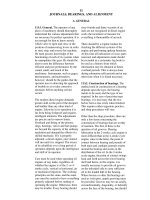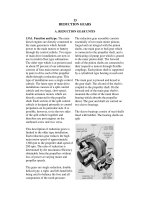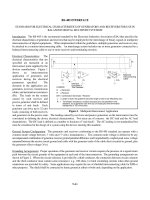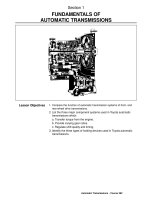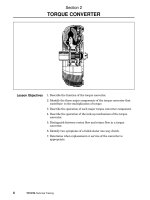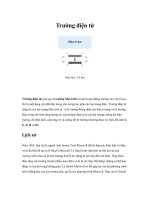Tài liệu PIC Robotics P2 pptx
Bạn đang xem bản rút gọn của tài liệu. Xem và tải ngay bản đầy đủ của tài liệu tại đây (1.75 MB, 20 trang )
From this point on, the MS-DOS Prompt window and the Command Prompt
window will be referred to as the DOS window. When the DOS window is
opened, you will be located in a subdirectory on the hard drive. Your prompt
may look like this: C:\WINDOWS�.
The DOS prompt provides vital information. The C: tells us we are on the C
drive. The \WINDOWS tells us we are in the Windows subdirectory.
We want to work from the root directory of the computer’s hard drive (usual-
ly the C drive). We accomplish this by using the
cd (change directory) command.
The cd command brings one up a single level in the directory hierarchy.
Using the cd\ command brings one up to the root directory regardless of how
deep (levels) one has moved into subdirectories
.
The root directory is the top of
the directory hierarchy. From the Windows subdirectory type in
cd\ and hit
the Enter key to move to the root directory of the hard drive. Type in (enter)
the following command and hit the Enter key
.
cd\
W
e already created our subdirectory PBP by using
Windows Explorer for the
PicBasic Pro compiler
. W
e w
ant to move into the PBP subdirectory
,
enter the
following command, and hit Enter.
Installing the Compiler 17
Figure 2.9 Starting Command Prompt window in Windows 2000 and XP.
18 Chapter Two
Figure 2.10 Using DOS commands in DOS Prompt window to execute PicBasic Pro installa-
tion program.
c:\> cd pbp
Next place the 3.5-in PicBasic Pro diskette into your A drive, and type the fol-
lowing at the DOS prompt:
c:\pcp> a:\pbpxxx -d
Here xxx is the version number of the compiler on the disk (see Fig. 2.10). This
command copies and installs all the required files into the PBP directory. With
the files safely loaded onto your hard drive, remove the diskette and store it in
a safe place, in case it is needed in the future.
The PicBasic Pro program is now installed. You may close the DOS window
and store the 3.5-in diskette.
3
Chapter
Installing the EPIC Software
Installing the EPIC software from Windows is simple. To install, run the
install.bat file on the 3.5-in EPIC diskette. The install.bat file exe-
cutes the main self-extracting program that automatically creates a subdirec-
tory EPIC on your computer’s hard drive, then decompresses the program and
its support files, and copies them into the EPIC subdirectory.
If a subdirectory called EPIC already exists on your hard drive, when you
run the
install.bat file, you will receive an error message.
If you are still in the same DOS session as in last chapter and want to con-
tinue to use DOS to install the EPIC software, skip down to the “Installing the
EPIC Software, DOS Version” section. For those who wish to use Windows to
install this software, continue to read.
Installing the EPIC Software in Windows
From Windows click on the Start button, then Run (see Fig. 3.1). Place the
EPIC programming diskette into the A drive. When the Run menu window
opens, select Browse. From the Browse window select the A drive. This action
will list the files on the A drive. Select the
install.bat file and click the
Open button (see Fig. 3.2).
This action brings you back to the Run window. The
install.bat file
should be listed in the window. See Fig. 3.3. Click on the OK button. This action
automatically opens a DOS window and starts the executable program on the
EPIC diskette. The executable program creates a new subdirectory on the com-
puter’s hard drive called EPIC. It decompresses and copies all the necessary
files into the EPIC subdirectory, as shown in Fig. 3.4.
If you just installed the EPIC program using
W
indows
, skip over the next
section, “Installing the EPIC Software, DOS Version” and continue reading at
the “Supplemental—Applications Directory” section.
Copyright © 2004 The McGraw-Hill Companies. Click here for terms of use.
19
20
Figure 3.1 Selecting Run option on Windows start menu.
Figure 3.2 Selecting install.bat file on EPIC diskette.
Figure 3.3 Hitting OK on install.bat to begin execution.
Figure 3.4 Self-extracting EPIC program running in MS-DOS window
.
22 Chapter Three
Installing the EPIC Software, DOS Version
If you are still operating in the same DOS session as in Chap. 2, move back
into the root directory, and enter at the prompt
c:\> pbp cd
If you are entering a new DOS window, the prompt may appear a little dif-
ferent, but the command is the same.
c:\> windows cd/
From the root directory of the C drive we will run the install.bat pro-
gram on the EPIC 3.5-in diskette. The self-extracting file creates itself a sub-
directory called EPIC. Place the 3.5-in EPIC diskette into the floppy drive. At
the DOS prompt enter
c:\> a:
This places the command prompt into the A drive; the command prompt
should look like this:
a:\>
Now run the install.bat file by entering the following command:
a:\> install.bat
This starts the self-extracting file that creates the EPIC subdirectory and
installs all the required files into the subdirectory.
With the program and files installed onto your hard drive, remove the
diskette and store it in a safe place, in case it is needed in the future.
Supplemental—Applications Directory
It would be a good idea at this time if we created another subdirectory where
we can store all our PicBasic application programs. This will keep the PBC (or
PBP) and EPIC directories clean, neat, and uncluttered with programs and
program revisions.
From Windows Explorer create an Applics subdirectory on your computer’s
hard drive
.
4
Chapter
CodeDesigner
In this chapter we will set up and work with the CodeDesigner software.
CodeDesigner is a Windows integrated development environment (IDE) inter-
face for the PIC series of microcontrollers. This IDE interface allows one to
write code, compile the code, and then program the code into a PIC microcon-
troller while staying in the same Windows environment.
The compiling of code within CodeDesigner still requires the use of one of
the PicBasic compilers. Programming the compiled code into a PIC microcon-
troller requires the EPIC software and hardware. CodeDesigner integrates
these software and hardware packages so that they can operate within its
Windows environment.
CodeDesigner has many useful features that help you write code and that
make it far superior to using a simple text editor.
CodeDesigner Features
■
AutoCodeCompletion. CodeDesigner makes writing code much easier with
smart pop-up list boxes that can automatically fill in statements and param-
eters for you.
■
Multidocument support.
■
Line error highlighting
.
Compile your PicBasic project and CodeDesigner
will read error data and highlight error lines.
■
QuickSyntaxHelp. The QuickSyntaxHelp feature displays statement syntax
when you type in a valid PicBasic statement.
■
Statement description. Statement descriptions are displayed in the status
bar when you type in a valid PicBasic statement.
■
Statement Help. Simply position your cursor over a PicBasic statement and
get statement-specific help
.
Copyright © 2004 The McGraw-Hill Companies. Click here for terms of use.
23
24 Chapter Four
■
Label listbox. The label listbox displays the current label and allows you to
select a label from the list to jump to.
■
Colored PicBasic syntax. This sets colors for reserved words, strings, num-
bers, comments, defines, etc. Colored PicBasic syntax makes for easy code
reading.
■
Bookmarks. Never lose your place again. CodeDesigner allows you to set
bookmarks.
■
Multiple undo/redo actions. If you didn’t want to delete that last line, it’s no
problem. Simply click on the Undo button.
■
Multiple views. Multiple views of your source code allow you to easily edit
your code.
■
Print source code.
■
Drag-and-drop text.
■
Row/column-based Insert, Delete, and Copy.
■
Search and replace.
■
Compile and launch device programmer.
One feature I like is that each typed line of code is color-coded, making it
easier to spot errors and read through your code.
When you purchase either the PicBasic or PicBasic Pro compilers, it is pack-
aged with an additional diskette that contains a free version of CodeDesigner
called CodeDesigner Lite. The Lite version allows you to write programs up to
150 lines and open up three source files at once for easy copy and paste. If you
would like to try CodeDesigner without purchasing a compiler, CodeDesigner
Lite is freely downloadable from the Internet (see Parts List at end of chapter).
The idea is, if you like the free CodeDesigner software, you can then upgrade
to the full-featured CodeDesigner. The standard version of CodeDesigner costs
$75.00 and removes the restrictions imposed in the Lite version. This standard
version allows you to write programs with an unlimited amount of code lines
and to open an unlimited amount of source files. Of course,
unlimited means
with respect to the limits of your computer’s capabilities.
If for any reason someone does not wish to use the CodeDesigner software
,
the procedures for writing code and compiling and programming a PICmicro
chip manually from a DOS environment are covered in Chap. 5.
CodeDesigner increases productivity and the ease with which you can write,
debug, and load PicBasic programs into the microcontroller. If there is a prob-
lem (more often than not), debugging the code and recompiling are much eas-
ier and faster when you are using CodeDesigner. When the program is
completely debugged, it can be uploaded into the PIC microcontroller via the
EPIC software and programming board. At this point the microcontroller and
circuit are tested. If they function properly, I’m finished; if not, I begin rewrit-
ing the program or redesigning the electronics.
CodeDesigner 25
Software Installation
The CodeDesigner software loads as most standard Windows software does.
Load the software on your computer’s hard drive according to the instructions
given with the software.
When CodeDesigner installs, it creates a subdirectory in the Program Files
directory. It places a CodeDesigner shortcut on the Start, Program menu in
Windows.
Setting CodeDesigner Options
In order for CodeDesigner to compile code and program the resulting code into
PIC microcontrollers, we need to configure the default locations where
CodeDesigner looks for its support programs. We set up the default locations
by entering the software paths where CodeDesigner stores programs, looks for
the PicBasic compiler and where to find the EPIC program.
Start the CodeDesigner software (see Fig. 4.1); the evaluation copy opens with
this version of the window. The next window is the standard opening screen to
the CodeDesigner software (see Fig. 4.2). To begin setting the options, click on
the Compile menu option and then on Compiler Options (see Fig. 4.3).
Figure 4.1 CodeDesigner Lite version start-up screen.
26 Chapter Four
Figure 4.2 Program written in CodeDesigner ready for compiling and programming.
Figure 4.3 Error created when Windows cannot identify EPIC Programmer attached to print-
er port.
CodeDesigner 27
Figure 4.4 Schematic for wink program.
The Compiler Options window opens (see Fig. 4.4). In the top text field, use
the pull-down menu to select which compiler you are using, the PicBasic Pro
or PicBasic. In Fig. 4.4 the PicBasic Pro compiler is chosen.
In the second text field, you select the compiler’s pathname. The compiler
path and name (
pbpw.exe) is chosen for the PicBasic Pro compiler, in the sub-
directory of C:\PBP.
In the third text field we choose where the CodeDesigner software looks to
load and save our source code files. Hit the Browse button next to the text
field. This opens a browser window (see Fig. 4.5); select the Applics subdirec-
tory on the hard drive and click on OK.
The “Default Source Code Directory”
text field now contains the path
“C:\Applics” subdirectory (see Fig. 4.6). Click the OK button to close the
Compiler Options window .
Now we need to set the Programmer Options
.
Click on the Programmer
,
Programmer Options on the top menu (see Fig. 4.7). This opens the
Programmer Options window (see F
ig
.
4.8). Click on the Browse button next to
the Programmer Pathname text field.
A browser window opens;
select the
epicwin.exe program in the EPIC subdirectory on your computer’s hard dri-
ve (see F
ig
.
4.9). Click Open, and this brings you back to the Programmer
Options window
.
The new path you select should be in the Programmer
Pathname text field (see Fig. 4.10). Click OK to set this option.
Figure 4.5 Complete circuit built on solderless breadboard.
Figure 4.6 Selecting compiler (CodeDesigner).
28
Figure 4.7 Opening Programmer options (CodeDesigner).
Figure 4.8 Programmer options window (CodeDesigner).
Figure 4.9 Selecting epicwin.exe Programmer in EPIC subdirectory.
Figure 4.10 Hitting OK to confirm selection.
30
CodeDesigner 31
With the CodeDesigner options set, we are ready to write our first program.
First Program
Start CodeDesigner and enter the following code for the PicBasic compiler.
‘First PicBasic program to wink two LEDs connected to port b.
loop: high 0 ‘Turn on LED connected to pin rb0
low 1 ‘Turn off LED connected to pin rb1
pause 500 ‘Delay for .5 second
low 0 ‘Turn off LED connected to pin rb0
high 1 ‘Turn on LED connected to pin rb1
pause 500 ‘Delay for .5 second
goto loop ‘Go back to loop and blink & wink LEDs forever
end
The next program is identical in function (not code) to the PicBasic program
above. Start CodeDesigner and enter the following code (see Fig. 4.11):
‘Wink program
‘Blinks and winks two LEDs connected to port b
Figure 4.1
1
PicBasic Pro program written in CodeDesigner
.
32 Chapter Four
loop:
high portb.0 ‘Turn on LED connected to rb0
low portb.1 ‘Turn off LED connected to rb1
pause 500 ‘Wait 1/2 second
low portb.0 ‘Turn off LED connected to rb0
high portb.1 ‘Turn on LED connected to rb1
pause 500 ‘Wait 1/2 second
goto loop ‘Loop back repeat cycle blink & wink forever
CodeDesigner defaults to writing code for the PIC 16F84 microcontroller. This
is the microcontroller I recommend to start with. To change the microcon-
troller, simply pull down the device menu and select the appropriate micro-
controller (see Fig. 4.12).
When CodeDesigner attempts to compile a program from the Windows envi-
ronment, it automatically opens a DOS Prompt window, compiles the program,
and then ends the DOS session.
To compile the program using CodeDesigner, either select compile under the
Compile menu or hit F5. CodeDesigner automatically starts the PicBasic Pro
compiler (or PicBasic compiler) to compile the program. Before you attempt to
compile a program, make sure you have set up Compiler Options under the
Compile menu.
Figure 4.12 Pull-down menu location for selecting microcontroller.
CodeDesigner 33
Figure 4.13 Error message generated when CodeDesigner cannot find Programmer.
Once the program is compiled, we can go to the next step of loading the pro-
gram into a PIC microcontroller chip.
Connect the EPIC programming board to the printer port. If your computer
has only one printer port, disconnect the printer, if one is connected, and attach
the EPIC programming board, using a 6-ft DB25 cable.
When you connect the EPIC programming board to the computer, there
should not be any microcontroller installed onto the board. If you have an ac
adapter for the EPIC programmer board, plug it into the board. If not, attach
two fresh 9-V batteries. Connect the “battery on” jumper to apply power. The
programming board must be connected to the printer port with power applied
to the programming board before the EPIC programming software is started.
If it is not,
the software will not see the programming board connected to the
printer port and will give the error message “EPIC Programmer Not Found”
(see F
ig. 4.13).
The EPIC Programming Board Software
T
o program the 16F84 microcontroller from within CodeDesigner
,
select the
Launc
h Programmer menu item from the Programmer menu,
or hit F6.
CodeDesigner automatically starts the
epicwin.exe Windows software.
34 Chapter Four
Figure 4.14 Setting configuration switches in epicwin.exe program.
With the EPIC Windows software started, set the configuration switches one
by one under the Options menu item (see Fig. 4.14).
Device: Sets the device type. Set it for 16F84 (default).
Memory Size (K): Sets memory size. Choose 1.
OSC: Sets oscillator type. Choose XT for crystal.
Watchdog Timer: Choose On.
Code Protect: Choose Off.
P
ower Up Timer Enable:
Choose On.
After the configuration switches are set, insert the PIC 16F84 microcontroller
into the open socket on the EPIC programming board.
If you received an error
message “EPIC Programmer Not Found”
when CodeDesigner started the
EPIC Windows program (see Fig. 4.13), you have the option of either trou-
bleshooting the problem or using the EPIC DOS program.
F
or instructions on
using the EPIC software
,
DOS version,
see Chap
.5.
The schematic of the circuit needed to test the PICmicro is given in Chap. 6.
If you ha
ve successfully written, compiled, and uploaded the code into the
PICmicro chip using CodeDesigner
,
then you can skip the DOS material in
Chap. 5 and pick up at “Testing the PIC Microcontroller” in Chap. 6.
CodeDesigner 35
Parts List
CodeDesigner Lite Free
Download from Internet at: www.imagesco.com/catalog/pic/codedesigner.html.
CodeDesigner Standard $75.00
Available from Images SI Inc. (see Suppliers at end of book).
This page intentionally left blank.




